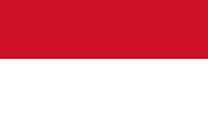Indonesia
Historical Background:
The Republic of Indonesia comprises some 13,466 islands. The name Indonesia comes from the Greek words 'Indos' and 'Nesos', meaning island. This is a term which began to be used to refer to the Indonesian archipelago around the 19th century, before independance, Indonesia was known as the Netherlands East Indies (Nederlandsch Oost Indie) for over three centuries.
The islands of Indonesia are very rich and vibrant, not only in biodiversity, but through the mixing and merging of many cultures over the past few millennia. Its location on the strategic sea lanes have made its coastal regions perfect for the encouragement and development of inter-island as well as international trade. The history of the country is very intricately tied up in its trade relations and potential, having already become an important international trading region by the 7th century, trading as far as with China and India. Indonesia came into contact with Hindu and Buddhist traders early on, shortly followed by traders from the Islamic world, leading to the eclipse of the Hindu and Buddhist religions by Islam by the mid 15th century or so. The first regular contact between Europe and Indonesia occurred following 1512, when the Portuguese sailor Francisco Serrao arrived seeking nutmeg, cloves and cubeb pepper. From then on the Islamic traders and Europeans competed with one another to monopolise the trade in and around the Spice Islands of Maluku during the Age of Discovery.
The first Dutch expedition set off for Indonesia in 1595 to access the spice trade. Following the establishment of the Dutch East India Company (VOC), they established a capital at Batavia (Jakarta), which became the centre of the VOC trading network. This marked the beginning of Dutch involvement and occupation with Indonesia. Through Batavia's sea trade links, the Netherlands were brought into contact with many more countries, communities and trading commodities across the whole of Asia.
During the VOC era, Indonesia was considered to be more of a trading post than Dutch colony. Although the Dutch did control the islands to some extent, they did not rule over the Indonesian archipelago. However the Netherlands did desire monopoly over the coveted trading goods, which led to the VOC acting as the law enforcement over the trade around the coastal areas and waters in the area. The Dutch were trading and producing nutmeg, mace space, cloves, cinammon, coffee, tea, cacao, tobacco, rubber, sugar and opium. In order to administer and organise their trade, the VOC built fortresses as a 'safety measure', becoming permanent settlements and defendable strongpoints for the company and the Dutch settlers. Meticulous detailed archives were kept covering all the VOC activities, and plantation systems were also introduced to increase trading commodities under VOC control. Evidence for this time is still very evidence in the tangible remains in Indonesia to this day.
Following the dissolution of the VOC in 1800, the Netherlands government established the Dutch East Indies as a nationalised colony. For the majority of the colonial period, the Dutch control was mainly concentrated over the coastal strongholds. It was only following the turn of the 20th century that the Dutch dominance extended to include almost across Indonesia's present boundaries. Indonesia was occupied during World War Two by the Japanese, and following their surrender to the Allies in 1945, the Indonesian nationalist leader Sukarno declared independance and was appointed as the first President of Indonesia. The Netherlands tried to re-establish their rule following the War, and the resulting conflict continued until 1949, when the Dutch recognised the Independance of Indonesia. This was excepting the Netherlands New Guinea, which was ceded to Indonesia in 1963.
Migration:
Following the abolition of the Slave Trade in 1863, the number of labourers on Surinamese plantations dropped significantly. The Dutch then began contracting Javanese labourers to sail to Suriname in order to work on the plantations. Many of the contracted labourers remained in Suriname and settled in the country following the end of their contract, whilst some also returned to Indonesia, often taking wives they met during their contract back home. Between 1831-1872 the Dutch also began recruiting Ghanaian men for the Dutch colonial army. Due to a lack of armed forces in Indonesia, many of these recruits were sent to serve in the Dutch East Indies. Over 3,000 men sailed to Java and fought on behalf of the Netherlands in Indonesia. Following the expiration of their contracts, many returned home to retire, but others also stayed in the area and raised families. There are still many people of Indo-African descent still living in the country.
During the Dutch occupation of Indonesia, many families and individuals migrated to and from the Netherlands. There are still many families and descendants on both sides who have origins in the other country. During and following the Indonesian struggle for independance, 296,200 people migrated to the Netherlands, and in fact only 92,200 had been born in the Netherlands, the numbers contained thousands of people of Indo-African, Indo-Dutch, Indonesian and Indo-Surinamese descent.
Heritage Cooperation:
The intervening years between World War Two and the turn of the century were difficult and sensitive between the two countries. In 2005 the Dutch Minister of Foreign Affairs attended the 60th Independence Celebration of Indonesia. This official attendance from the Dutch government led to improved diplomatic relations between the Netherlands and Indonesia.
In 2006 plans were made to sign a Joint Policy Framework, but during the journey of the Dutch Secretary of State to Indonesia, the Dutch government collapsed and she no longer had the authority to sign the framework. However despite the lack of official paperwork, cooperation in the field of heritage between the two countries continues to gather momentum and improve to this day. Indonesia has become focal to Dutch international heritage activities, as it is listed as one of the Priority Countries for the Netherlands under the Dutch Mutual Cultural Heritage Policy.




